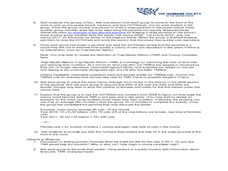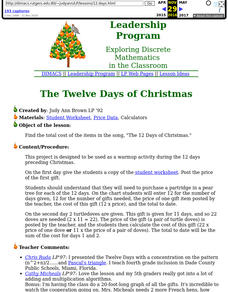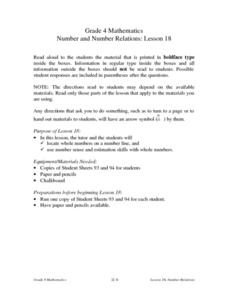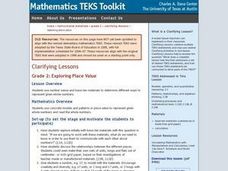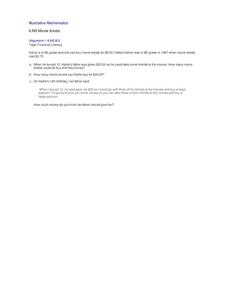Curated OER
Order of Operations Showdown
In this mathematics worksheet, students solve a number of various problems by applying the rules of the order of operations. The divide, multiply, add, subtract where necessary. There are 12 problems to solve on the sheet.
Curated OER
Division Speed Drill
In this mathematics worksheet, 4th graders solve a number of problems by dividing a two-digit number by a single digit number. There are 36 problems to solve on the sheet.
Curated OER
Divisibility Rules Study Guide
For this mathematics worksheet, 4th graders write the divisibility rule for each factor given. Then they practice the rules by dividing the numbers listed by each factor and place a check mark in the box if it is a factor of the number.
Curated OER
Mathematical Properties for Addition
In this math worksheet, students read about and learn the properties of addition. Students study the commutative, associative, identity and inverse properties. There are no problems on this page for students to solve.
Curated OER
Multiplying Using the Commutative and Associative Properties
Third graders practice using the commutative and associative properties. In this multiplication lesson, 3rd graders simplify a series of problems using multiplication sentences and complete a worksheet.
Curated OER
Two By One Multiplication
Third graders use base-ten blocks to find products of two-digits by one-digit by making a model of the problem. They complete a worksheet by multiplying 2-digits by 1-digit with regrouping. They may use the base-ten blocks if needed.
Curated OER
The Tale of the Feral - Care and Multiplication of Feral Cats
Students differentiate between a feral cat and a domesticated cat. In this cat lesson plan, students use the scientific method, calculate averages, solve story problems, and learn how a caretaker can help a feral colony live safely.
Curated OER
Multiplication and Division with Arrays
Students practice the commutative property, create and manipulate arrays and multiply and divide numbers.
Curated OER
Casting Out Nines
Students identify division problems with no remainders. In this division lesson plan, students learn to decipher division problems using addition and subtraction to determine if the problem will contain a remainder.
Curated OER
Leadership Program in Discrete Mathematics
Students find the total cost of the items in the song, "The 12 Days of Christmas."
Curated OER
Working with Cuisenaire Rods In Mathematics
Fourth graders learn the numerical value of each underlined letter of the standard Rod Code and develop systematic usage for building new units.
Curated OER
Number and Number Relations
Upper graders multiply numbers by tens and hundreds, and multiply two and three digit numbers by one digit numbers. They participate in a teacher-led lecture and complete examples with the class, complete a worksheet, and discuss the...
Laboratory for Atmospheric and Space Physics
Where Are We Going?
Come take a ride on the space bus! Scholars go on an imaginary trip to pick up their peers from the inner and outer planets while reinforcing math skills. First, learners round decimals to identify each planets' distance from Earth....
Illustrative Mathematics
Sugar in Six Cans of Soda
Understanding how to multiply a whole number by a fraction is the key concept. Young mathematicians create a visual model of this real-world example and find the solution. Extensions are possible for making this an even richer activity....
Illustrative Mathematics
Equivalent Expressions
Here is a straight-forward problem of multiplying two binomials with a twist. It is up to algebra learners to decide how to turn this product of sums into a sum of products. However, it is not the quadratic that is the answer; it is the...
Willow Tree
Number Properties
The number of basic algebraic properties can become overwhelming for learners. A lesson explains and gives examples for all the basic algebraic properties. The resource is perfect to use as a way for pupils to organize and study the...
Curated OER
Fantastic Fraction Fudge
In order to create some tasty fudge, learners must adapt a recipe. Using a recipe for fudge, ingredients must be correctly converted using fractions. If one fraction is incorrect, the fudge will reveal it! Although you will only make one...
Alabama Learning Exchange
Add, Subtract, and Multiply Matrices
Introduce the concept of matrices with a pre-designed instructional activity. Learners watch video lessons to learn the ins and outs of adding, subtracting, and multiplying matrices. Using provided problems, they practice each operation...
Curated OER
Problem Solvers
Fifth and sixth graders compare decimals to the place-value structure in the base-ten number system. They represent fractions as parts of unit wholes, as parts of a set, as locations on a number line, and as divisions of whole numbers....
Alabama Learning Exchange
Binomial Expansion—Shortcut Please
There has got to be a better way; you just have to find it! Given a general binomial to expand with increasing powers, pupils realize that there must be a better way than multiple multiplications. Classmates look for patterns and use...
Curated OER
Grade 2: Exploring Place Value
Creative problem solving is fun and helps kids conceptualize content. They use grid paper, manilla paper, and markers to cut, draw, and show given double-digit numbers as many ways as they can.
Illustrative Mathematics
Movie tickets
This is a good Common Core question that relates inflation to operations with decimals and rounding. Young learners are asked to find out if an amount of money can purchase the same amount of movie tickets in 2012 as it did in 1987. They...
Curated OER
Lesson 3: Number Sense
Learners solve word problems using number sense. They convert fractions to decimals and mixed numbers. Pupils determine if a given fraction is greater or less than another fraction, and order numbers on a number line.
Illustrative Mathematics
Doubling Numerators and Denominators
Understanding the meaning of fractions is a challenge for many young learners. These two questions examine what happens when the numerator and denominator of a fraction are doubled. Consider allowing young scholars to discuss their ideas...








